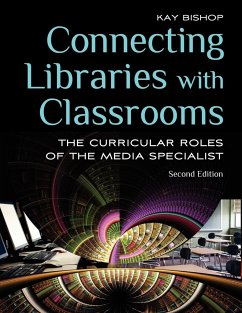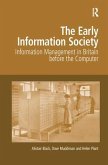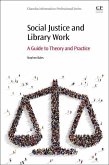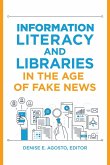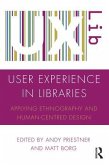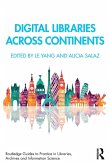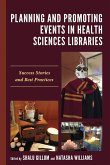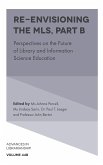- Broschiertes Buch
- Merkliste
- Auf die Merkliste
- Bewerten Bewerten
- Teilen
- Produkt teilen
- Produkterinnerung
- Produkterinnerung
This book provides an in-depth exploration of the topics that are currently relevant in K-12 curricula, including the school librarian's role in dealing with these issues, collaborating with teachers, and connecting to classrooms.
Andere Kunden interessierten sich auch für
![The Early Information Society The Early Information Society]() Alistair BlackThe Early Information Society57,99 €
Alistair BlackThe Early Information Society57,99 €![Social Justice and Library Work Social Justice and Library Work]() Stephen BalesSocial Justice and Library Work63,99 €
Stephen BalesSocial Justice and Library Work63,99 €![Information Literacy and Libraries in the Age of Fake News Information Literacy and Libraries in the Age of Fake News]() Information Literacy and Libraries in the Age of Fake News67,99 €
Information Literacy and Libraries in the Age of Fake News67,99 €![User Experience in Libraries User Experience in Libraries]() User Experience in Libraries50,99 €
User Experience in Libraries50,99 €![Digital Libraries Across Continents Digital Libraries Across Continents]() Digital Libraries Across Continents34,99 €
Digital Libraries Across Continents34,99 €![Planning and Promoting Events in Health Sciences Libraries Planning and Promoting Events in Health Sciences Libraries]() Planning and Promoting Events in Health Sciences Libraries69,99 €
Planning and Promoting Events in Health Sciences Libraries69,99 €![Re-envisioning the MLS Re-envisioning the MLS]() Johnna PercellRe-envisioning the MLS132,99 €
Johnna PercellRe-envisioning the MLS132,99 €-
-
-
This book provides an in-depth exploration of the topics that are currently relevant in K-12 curricula, including the school librarian's role in dealing with these issues, collaborating with teachers, and connecting to classrooms.
Produktdetails
- Produktdetails
- Verlag: ABC-CLIO
- 2 Revised edition
- Seitenzahl: 140
- Erscheinungstermin: 9. März 2011
- Englisch
- Abmessung: 280mm x 216mm x 8mm
- Gewicht: 402g
- ISBN-13: 9781598845990
- ISBN-10: 1598845993
- Artikelnr.: 32206573
- Herstellerkennzeichnung
- Libri GmbH
- Europaallee 1
- 36244 Bad Hersfeld
- gpsr@libri.de
- Verlag: ABC-CLIO
- 2 Revised edition
- Seitenzahl: 140
- Erscheinungstermin: 9. März 2011
- Englisch
- Abmessung: 280mm x 216mm x 8mm
- Gewicht: 402g
- ISBN-13: 9781598845990
- ISBN-10: 1598845993
- Artikelnr.: 32206573
- Herstellerkennzeichnung
- Libri GmbH
- Europaallee 1
- 36244 Bad Hersfeld
- gpsr@libri.de
Kay Bishop
About the Author
Acknowledgments
Author's Note
Introduction
Chapter 1 Collaboration and Partnerships
Collaboration
Authentic Learning and Constructivism
Inquiry-Based Learning
Connecting the School Library to the Curriculum
Information Literacy
Partnerships
Instructional Partner with Teachers
Principal
Students
The Community
Conclusions
References
Suggested Activities
Subject Areas and the Media Specialist
Chapter 2 Reading in the Elementary School
Standards and Assessments
Reading and NCLB
Test Results
Response to Intervention
Research
The Role of the School Librarian
AASL and Reading
Contributions to School-Wide Literacy
Professional Library
Conclusions
References
Suggested Activities
Chapter 3 Music in the Middle School
Standards and Assessments
Music Education and NCLB
Research
The Role of the School Librarian
Collaborative Activities
Music and Copyright
Conclusions
References
Suggested Activities
Chapter 4 English as a Second Language in the High School
Educational Challenges
Standards and Assessments
Teaching English as a Second Language
ELLs in Mainstream or Inclusive Classrooms
The Role of the School Librarian
Literature
Technology
Conclusions
References
Suggested Activities
Learning More about Subject Areas
Special Groups of Students and the School Librarian
Chapter 5 Students Who Are Autistic
Legislation
Educational Programming
Individualized Educational Plans
Inclusion
Organizations and Publications
The Role of the School Librarian
Instructional Strategies
Helpful Resources
Teacher and Parent Resource Collections
Books for Students
Conclusions
References
Suggested Activities
Chapter 6 Highly Mobile Students
Legislation
Impact of Student Mobility
School Efforts
The Role of the School Librarian
Helpful Resources
Homeless
Migrant and Immigrants
Foster Children and Orphans
Military
Collaborating with Others
Conclusions
References
Suggested Activities
Chapter 7 Students with Gay, Lesbian, Bisexual, or Transgender Orientations
Definitions
Legislation
LGBT Issues in the Curriculum
Organizations and Publications
The Role of the School Librarian
Supporting LGBT Students
Literature
Conclusions
References
Suggested Activities
Learning More about Special Groups of Students
Educational Trends and the School Librarian
Chapter 8 Web 2.0
Controversy
Barriers
Benefits
Teaching with Web 2.0
The Role of the School Librarian
Student Online Safety
Professional Development
Conclusions
References
Suggested Activities
Chapter 9 Distance Education
Definitions
Controversy
Benefits
Challenges
Research Studies
The Role of the School Librarian
Conclusions
References
Suggested Activities
Chapter 10 Inclusion
Federal Legislation
Controversy
Opponents of Inclusion
Proponents of Inclusion
Recommendations for Implementing Inclusion
The Role of the School Librarian
Physical Facility Considerations
Collaboration with Special Education and Classroom Teachers
Assistive Technology
Conclusions
References
Suggested Activities
Learning More about Educational Trends
Appendix: Bibliography
Index
Acknowledgments
Author's Note
Introduction
Chapter 1 Collaboration and Partnerships
Collaboration
Authentic Learning and Constructivism
Inquiry-Based Learning
Connecting the School Library to the Curriculum
Information Literacy
Partnerships
Instructional Partner with Teachers
Principal
Students
The Community
Conclusions
References
Suggested Activities
Subject Areas and the Media Specialist
Chapter 2 Reading in the Elementary School
Standards and Assessments
Reading and NCLB
Test Results
Response to Intervention
Research
The Role of the School Librarian
AASL and Reading
Contributions to School-Wide Literacy
Professional Library
Conclusions
References
Suggested Activities
Chapter 3 Music in the Middle School
Standards and Assessments
Music Education and NCLB
Research
The Role of the School Librarian
Collaborative Activities
Music and Copyright
Conclusions
References
Suggested Activities
Chapter 4 English as a Second Language in the High School
Educational Challenges
Standards and Assessments
Teaching English as a Second Language
ELLs in Mainstream or Inclusive Classrooms
The Role of the School Librarian
Literature
Technology
Conclusions
References
Suggested Activities
Learning More about Subject Areas
Special Groups of Students and the School Librarian
Chapter 5 Students Who Are Autistic
Legislation
Educational Programming
Individualized Educational Plans
Inclusion
Organizations and Publications
The Role of the School Librarian
Instructional Strategies
Helpful Resources
Teacher and Parent Resource Collections
Books for Students
Conclusions
References
Suggested Activities
Chapter 6 Highly Mobile Students
Legislation
Impact of Student Mobility
School Efforts
The Role of the School Librarian
Helpful Resources
Homeless
Migrant and Immigrants
Foster Children and Orphans
Military
Collaborating with Others
Conclusions
References
Suggested Activities
Chapter 7 Students with Gay, Lesbian, Bisexual, or Transgender Orientations
Definitions
Legislation
LGBT Issues in the Curriculum
Organizations and Publications
The Role of the School Librarian
Supporting LGBT Students
Literature
Conclusions
References
Suggested Activities
Learning More about Special Groups of Students
Educational Trends and the School Librarian
Chapter 8 Web 2.0
Controversy
Barriers
Benefits
Teaching with Web 2.0
The Role of the School Librarian
Student Online Safety
Professional Development
Conclusions
References
Suggested Activities
Chapter 9 Distance Education
Definitions
Controversy
Benefits
Challenges
Research Studies
The Role of the School Librarian
Conclusions
References
Suggested Activities
Chapter 10 Inclusion
Federal Legislation
Controversy
Opponents of Inclusion
Proponents of Inclusion
Recommendations for Implementing Inclusion
The Role of the School Librarian
Physical Facility Considerations
Collaboration with Special Education and Classroom Teachers
Assistive Technology
Conclusions
References
Suggested Activities
Learning More about Educational Trends
Appendix: Bibliography
Index
About the Author
Acknowledgments
Author's Note
Introduction
Chapter 1 Collaboration and Partnerships
Collaboration
Authentic Learning and Constructivism
Inquiry-Based Learning
Connecting the School Library to the Curriculum
Information Literacy
Partnerships
Instructional Partner with Teachers
Principal
Students
The Community
Conclusions
References
Suggested Activities
Subject Areas and the Media Specialist
Chapter 2 Reading in the Elementary School
Standards and Assessments
Reading and NCLB
Test Results
Response to Intervention
Research
The Role of the School Librarian
AASL and Reading
Contributions to School-Wide Literacy
Professional Library
Conclusions
References
Suggested Activities
Chapter 3 Music in the Middle School
Standards and Assessments
Music Education and NCLB
Research
The Role of the School Librarian
Collaborative Activities
Music and Copyright
Conclusions
References
Suggested Activities
Chapter 4 English as a Second Language in the High School
Educational Challenges
Standards and Assessments
Teaching English as a Second Language
ELLs in Mainstream or Inclusive Classrooms
The Role of the School Librarian
Literature
Technology
Conclusions
References
Suggested Activities
Learning More about Subject Areas
Special Groups of Students and the School Librarian
Chapter 5 Students Who Are Autistic
Legislation
Educational Programming
Individualized Educational Plans
Inclusion
Organizations and Publications
The Role of the School Librarian
Instructional Strategies
Helpful Resources
Teacher and Parent Resource Collections
Books for Students
Conclusions
References
Suggested Activities
Chapter 6 Highly Mobile Students
Legislation
Impact of Student Mobility
School Efforts
The Role of the School Librarian
Helpful Resources
Homeless
Migrant and Immigrants
Foster Children and Orphans
Military
Collaborating with Others
Conclusions
References
Suggested Activities
Chapter 7 Students with Gay, Lesbian, Bisexual, or Transgender Orientations
Definitions
Legislation
LGBT Issues in the Curriculum
Organizations and Publications
The Role of the School Librarian
Supporting LGBT Students
Literature
Conclusions
References
Suggested Activities
Learning More about Special Groups of Students
Educational Trends and the School Librarian
Chapter 8 Web 2.0
Controversy
Barriers
Benefits
Teaching with Web 2.0
The Role of the School Librarian
Student Online Safety
Professional Development
Conclusions
References
Suggested Activities
Chapter 9 Distance Education
Definitions
Controversy
Benefits
Challenges
Research Studies
The Role of the School Librarian
Conclusions
References
Suggested Activities
Chapter 10 Inclusion
Federal Legislation
Controversy
Opponents of Inclusion
Proponents of Inclusion
Recommendations for Implementing Inclusion
The Role of the School Librarian
Physical Facility Considerations
Collaboration with Special Education and Classroom Teachers
Assistive Technology
Conclusions
References
Suggested Activities
Learning More about Educational Trends
Appendix: Bibliography
Index
Acknowledgments
Author's Note
Introduction
Chapter 1 Collaboration and Partnerships
Collaboration
Authentic Learning and Constructivism
Inquiry-Based Learning
Connecting the School Library to the Curriculum
Information Literacy
Partnerships
Instructional Partner with Teachers
Principal
Students
The Community
Conclusions
References
Suggested Activities
Subject Areas and the Media Specialist
Chapter 2 Reading in the Elementary School
Standards and Assessments
Reading and NCLB
Test Results
Response to Intervention
Research
The Role of the School Librarian
AASL and Reading
Contributions to School-Wide Literacy
Professional Library
Conclusions
References
Suggested Activities
Chapter 3 Music in the Middle School
Standards and Assessments
Music Education and NCLB
Research
The Role of the School Librarian
Collaborative Activities
Music and Copyright
Conclusions
References
Suggested Activities
Chapter 4 English as a Second Language in the High School
Educational Challenges
Standards and Assessments
Teaching English as a Second Language
ELLs in Mainstream or Inclusive Classrooms
The Role of the School Librarian
Literature
Technology
Conclusions
References
Suggested Activities
Learning More about Subject Areas
Special Groups of Students and the School Librarian
Chapter 5 Students Who Are Autistic
Legislation
Educational Programming
Individualized Educational Plans
Inclusion
Organizations and Publications
The Role of the School Librarian
Instructional Strategies
Helpful Resources
Teacher and Parent Resource Collections
Books for Students
Conclusions
References
Suggested Activities
Chapter 6 Highly Mobile Students
Legislation
Impact of Student Mobility
School Efforts
The Role of the School Librarian
Helpful Resources
Homeless
Migrant and Immigrants
Foster Children and Orphans
Military
Collaborating with Others
Conclusions
References
Suggested Activities
Chapter 7 Students with Gay, Lesbian, Bisexual, or Transgender Orientations
Definitions
Legislation
LGBT Issues in the Curriculum
Organizations and Publications
The Role of the School Librarian
Supporting LGBT Students
Literature
Conclusions
References
Suggested Activities
Learning More about Special Groups of Students
Educational Trends and the School Librarian
Chapter 8 Web 2.0
Controversy
Barriers
Benefits
Teaching with Web 2.0
The Role of the School Librarian
Student Online Safety
Professional Development
Conclusions
References
Suggested Activities
Chapter 9 Distance Education
Definitions
Controversy
Benefits
Challenges
Research Studies
The Role of the School Librarian
Conclusions
References
Suggested Activities
Chapter 10 Inclusion
Federal Legislation
Controversy
Opponents of Inclusion
Proponents of Inclusion
Recommendations for Implementing Inclusion
The Role of the School Librarian
Physical Facility Considerations
Collaboration with Special Education and Classroom Teachers
Assistive Technology
Conclusions
References
Suggested Activities
Learning More about Educational Trends
Appendix: Bibliography
Index

